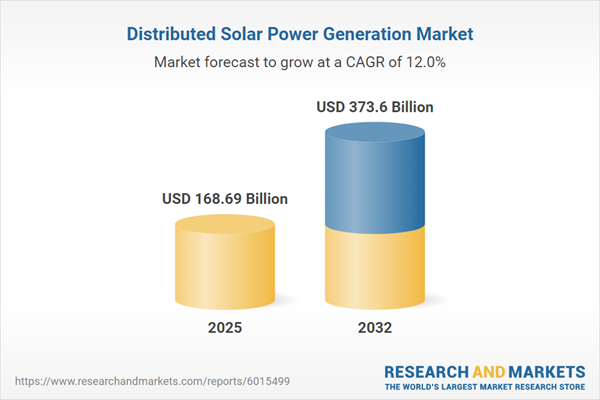Speak directly to the analyst to clarify any post sales queries you may have.
The distributed solar power generation market is rapidly transforming global energy systems, enabling resilient, localized solutions for diverse users across advanced and emerging economies. This trend is shifting utilities, businesses, and communities toward a decentralized and digital energy future.
Market Snapshot: Distributed Solar Power Generation 2024–2032
The distributed solar power generation market grew from USD 150.53 billion in 2024 to USD 168.69 billion in 2025 and is forecast to reach USD 373.60 billion by 2032, with a CAGR of 12.03%. This robust trajectory reflects accelerating deployment across residential, commercial, and remote applications, driven by technology advances, policy catalysts, and emerging financing models. Senior decision-makers benefit from visibility into this dynamic sector, which is reshaping traditional supply chains and value propositions through rapid adoption and integration of decentralized assets.
Scope & Segmentation: Key Structures in Distributed Solar
- Grid Connection: Hybrid, Off-Grid, On-Grid systems empower flexible deployment strategies based on local infrastructure availability.
- Module Material: Crystalline silicon (Monocrystalline, Polycrystalline) and Thin-Film (Amorphous Silicon, CdTe, CIGS) technologies support a diverse range of installation environments and use cases.
- Mounting: Options include Floating, Ground-Mounted (Fixed, Tracking), and Rooftop configurations, each optimized for site-specific and operational considerations.
- Component: Balance of System, Inverters (Micro, String), Modules, Mounting Structure – each playing distinct roles in performance and project economics.
- End User: Commercial and Industrial, Residential sectors, each pursuing solar adoption for different motivations and scale.
- Application: Use cases span Rural Electrification, Street Lighting, Telecom, and Water Pumping, demonstrating solar’s adaptability and mission-critical value in varied contexts.
- Regional Coverage: Americas (including the United States, Canada, Mexico, Brazil, Argentina, Chile), Europe, Middle East, Africa (touching major economies and high-growth regions), Asia-Pacific (China, India, Japan, Australia, Southeast Asia, and more).
- Leading Companies: Market leaders and innovators analyzed include Sunrun Inc., Tesla, Inc., Sunnova Energy International Inc., SunPower Corporation, Enphase Energy, SolarEdge Technologies, Canadian Solar, First Solar, JinkoSolar, and Trina Solar Co., among others.
Key Takeaways for Senior Decision-Makers
- The distributed solar power generation market is moving from experimental projects to robust, scalable implementations, changing utility and business energy strategies globally.
- Technology advancements in photovoltaics, inverter sophistication, and energy storage are lowering costs and enabling greater system reliability and flexibility.
- Supportive policy frameworks and incentives are accelerating the pace of distributed solar deployment, increasing stakeholder participation along the value chain.
- Utilities and private offtakers are adopting new financing vehicles and hybrid business models, integrating centralized and distributed assets for optimized energy delivery.
- Adapting to evolving regional policies, supply chain shifts, and end-user requirements is critical for companies aiming to maintain or expand market share.
- Digital integration—such as remote monitoring, predictive analytics, and microgrid controls—is reshaping asset management and expanding value streams for operators and customers.
Tariff Impact on Supply Chains & Cost Structures
Recent U.S. tariff measures have influenced global supply strategies, prompting shifts toward localized assembly, new manufacturer partnerships, and contract reforms to manage cost volatility. While some segments experienced price increases, renewed investment in domestic production and automated manufacturing has stimulated product innovation and operational adaptability. Organizations that respond strategically to such regulatory inflection points position themselves to capitalize on future market openings.
Methodology & Data Sources
This analysis is based on extensive primary interviews with senior executives and secondary reviews of industry publications, regulatory documents, and technical white papers. Quantitative and qualitative data are rigorously cross-verified and triangulated, with findings refined through peer reviews and expert workshops to ensure comprehensive, credible insights.
Why This Report Matters: Actionable Insights & Strategic Value
- Facilitates informed decision-making by providing granular segmentation and regional analysis for distributed solar power generation.
- Delivers clarity on competitive positioning, technology innovations, and evolving policy landscapes affecting investment and deployment strategies.
- Equips industry leaders with targeted recommendations to enhance supply chain resilience, unlock new customer segments, and prioritize digital transformation within their operations.
Conclusion
The distributed solar power generation sector is rapidly evolving, with innovation, policy, and market forces converging to unlock new growth opportunities. Strategic adaptation, technology integration, and ongoing cross-sector collaboration will shape future leaders in this dynamic marketplace.
Additional Product Information:
- Purchase of this report includes 1 year online access with quarterly updates.
- This report can be updated on request. Please contact our Customer Experience team using the Ask a Question widget on our website.
Table of Contents
3. Executive Summary
4. Market Overview
7. Cumulative Impact of Artificial Intelligence 2025
Companies Mentioned
The companies profiled in this Distributed Solar Power Generation market report include:- Sunrun Inc.
- Tesla, Inc.
- Sunnova Energy International Inc.
- SunPower Corporation
- Enphase Energy, Inc.
- SolarEdge Technologies, Inc.
- Canadian Solar Inc.
- First Solar, Inc.
- JinkoSolar Holding Co., Ltd.
- Trina Solar Co., Ltd.
Table Information
| Report Attribute | Details |
|---|---|
| No. of Pages | 180 |
| Published | October 2025 |
| Forecast Period | 2025 - 2032 |
| Estimated Market Value ( USD | $ 168.69 Billion |
| Forecasted Market Value ( USD | $ 373.6 Billion |
| Compound Annual Growth Rate | 12.0% |
| Regions Covered | Global |
| No. of Companies Mentioned | 11 |









